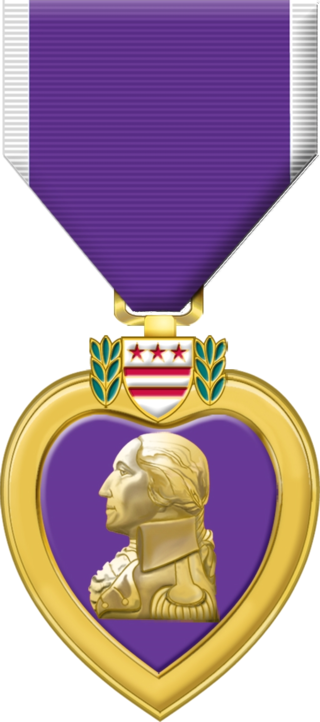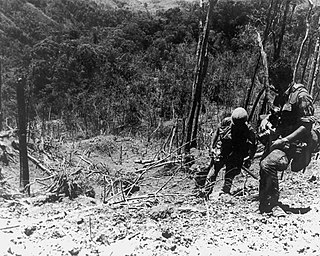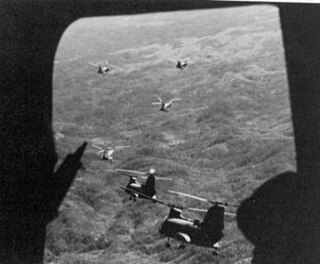
The Purple Heart (PH) is a United States military decoration awarded in the name of the president to those wounded or killed while serving, on or after 5 April 1917, with the U.S. military. With its forerunner, the Badge of Military Merit, which took the form of a heart made of purple cloth, the Purple Heart is the oldest military award still given to U.S. military members. The National Purple Heart Hall of Honor is located in New Windsor, New York.

Platoon is a 1986 American war film written and directed by Oliver Stone, starring Tom Berenger, Willem Dafoe, Charlie Sheen, Keith David, Kevin Dillon, John C. McGinley, Forest Whitaker, and Johnny Depp. It is the first film of a trilogy of Vietnam War films directed by Stone, followed by Born on the Fourth of July (1989) and Heaven & Earth (1993). The film, based on Stone's experience from the war, follows a new U.S. Army volunteer (Sheen) serving in Vietnam while his Platoon Sergeant and his Squad Leader argue over the morality in the platoon and of the war itself.

The Battle of Khe Sanh was conducted in the Khe Sanh area of northwestern Quảng Trị Province, Republic of Vietnam, during the Vietnam War. The main US forces defending Khe Sanh Combat Base (KSCB) were two regiments of the United States Marine Corps supported by elements from the United States Army and the United States Air Force (USAF), as well as a small number of Army of the Republic of Vietnam (ARVN) troops. These were pitted against two to three divisional-size elements of the North Vietnamese People's Army of Vietnam (PAVN).

The battle of Dak To in Vietnam was a series of major engagements of the Vietnam War that took place between 3 and 23 November 1967, in Kon Tum Province, in the Central Highlands of the Republic of Vietnam. The action at Đắk Tô was one of a series of People's Army of Vietnam (PAVN) offensive initiatives that began during the second half of the year. PAVN attacks at Lộc Ninh, Sông Bé and at Con Thien and Khe Sanh,, were other actions which, combined with Đắk Tô, became known as "the border battles". The post hoc purported objective of the PAVN forces was to distract American and South Vietnamese forces away from cities towards the borders in preparation for the Tet Offensive.

Operation Starlite was the first major offensive action conducted by a purely U.S. military unit during the Vietnam War from 18 to 24 August 1965. The operation was launched based on intelligence provided by Major general Nguyen Chanh Thi, the Army of the Republic of Vietnam (ARVN) I Corps commander. III Marine Amphibious Force commander Lieutenant General Lewis W. Walt devised a plan to launch a pre-emptive strike against the Viet Cong (VC) 1st Regiment to nullify their threat to the vital Chu Lai Air Base and Base Area and ensure its powerful communication tower remained intact.

The Battle of Ia Drang was the first major battle between the United States Army and the People's Army of Vietnam (PAVN), as part of the Pleiku Campaign conducted early in the Vietnam War, at the eastern foot of the Chu Pong Massif in the central highlands of Vietnam, in 1965. It is notable for being the first large scale helicopter air assault and also the first use of Boeing B-52 Stratofortress strategic bombers in a tactical support role. Ia Drang set the blueprint for the Vietnam War with the Americans relying on air mobility, artillery fire and close air support, while the PAVN neutralized that firepower by quickly engaging American forces at very close range.

Rules of Engagement is a 2000 American war legal drama film, directed by William Friedkin, written by Stephen Gaghan, from a story by Jim Webb, and starring Tommy Lee Jones and Samuel L. Jackson. Jackson plays U.S. Marine Colonel Terry Childers, who is brought to court-martial after Marines under his orders kill several civilians outside the U.S. embassy in Yemen.

James Henry Webb Jr. is an American politician and author. He has served as a United States senator from Virginia, Secretary of the Navy, Assistant Secretary of Defense for Reserve Affairs, Counsel for the United States House Committee on Veterans' Affairs and is a Marine Corps officer.

The Battle of Hamburger Hill was fought by US Army and Army of the Republic of Vietnam (ARVN) forces against People's Army of Vietnam (PAVN) forces during Operation Apache Snow of the Vietnam War. Though the heavily-fortified Hill 937, a ridge of the mountain Dong Ap Bia in central Vietnam near its western border with Laos, had little strategic value, US command ordered its capture by a frontal assault, only to abandon it soon thereafter. The action caused a controversy among both the US armed services and the public back home, and marked a turning point in the U.S. involvement.

Dale Adam Dye Jr. is an American actor, technical advisor, radio personality and writer. A decorated Marine veteran of the Vietnam War, Dye is the founder and head of Warriors, Inc., a technical advisory company specializing in portraying realistic military action in Hollywood films. Dye has also offered his expertise to television, such as the HBO miniseries Band of Brothers and The Pacific, the Apple TV+ miniseries Masters of the Air, and video games, including the Medal of Honor series.

Francis J. "Bing" West Jr. is an American author, Marine combat veteran and former Assistant Secretary of Defense for International Security Affairs during the Reagan Administration.

The Short-Timers is a 1979 semi-autobiographical novel by U.S. Marine Corps veteran Gustav Hasford, about his experience in the Vietnam War. Hasford served as a combat correspondent with the 1st Marine Division during the Tet Offensive of 1968. As a military journalist, he wrote stories for Leatherneck Magazine, Pacific Stars and Stripes, and Sea Tiger. The novel was adapted into the film Full Metal Jacket (1987), co-scripted by Hasford, Michael Herr, and Stanley Kubrick.

United States Marine Corps Scout Sniper was a secondary MOS designator of U.S. Marine Corps infantrymen and reconnaissance Marines that have graduated from a U.S. Marine Corps Scout Sniper School. Scout Snipers must earn the rank of Lance Corporal, be selected by their battalion to join the scout-sniper platoon, and complete an approved scout-sniper course in order to receive this designation. As of December 2023, Marine scout snipers have been reorganized as MOS 0322 Reconnaissance Sniper Marines, as part of a 26-Marine Scout Platoon.
David Sherman was an American novelist who dealt overwhelmingly with military themes at the small-unit tactical level. His experiences as a United States Marine informed his writings.

The 3rd Reconnaissance Battalion conducts amphibious and ground reconnaissance in support of the 3rd Marine Division and Marine Forces Pacific (MarForPac), operating in the commander's areas of influence. The battalion is based out of Camp Schwab, a satellite base of Marine Corps Base Camp Smedley D. Butler. It is geographically located on the Okinawa Prefecture in Japan.
Robert Russell Garwood is a former United States Marine. Often cited as the last verified American prisoner of war (POW) from the Vietnam War, Garwood was captured on September 28, 1965 by Việt Cộng forces near Da Nang, Quang Nam Province. He was taken to North Vietnam in 1969, and although he was reportedly released in 1973 along with the other U.S. POWs as part of the Paris Peace Accords, he did not return to the United States until March 22, 1979.

Lieutenant Colonel Howard Vincent Lee was a United States Marine Corps officer who received the Medal of Honor for heroism in August 1966 during the Vietnam War.

Operation Dewey Canyon was the last major offensive by the 3rd Marine Division during the Vietnam War. It took place from 22 January through 18 March 1969 and involved a sweep of the People's Army of Vietnam (PAVN)–dominated A Shau and Song Đa Krông Valleys by the 9th Marine Regiment. Based on intelligence and captured documents, the PAVN unit in contact was believed to be the 9th Regiment.

Matterhorn: A Novel of the Vietnam War is a novel by American author and decorated Marine, Karl Marlantes. It was first published by El León Literary Arts in 2009 and re-issued as a major publication of Atlantic Monthly Press on March 23, 2010.
Company E, 52nd Infantry, (LRP) was a 120 man-sized long-range reconnaissance patrol unit attached to the 1st Cavalry Division (Airmobile) in Vietnam in 1967-69. Its origin begins on January 1, 1967, as "LRRP Detachment G2," 1st Cavalry Division (Airmobile). It was then redesignated "Headquarters & Headquarters Company LRRP Detachment" in April 1967, and redesignated "Company E, 52nd Infantry (LRP)" on December 20, 1967.

















